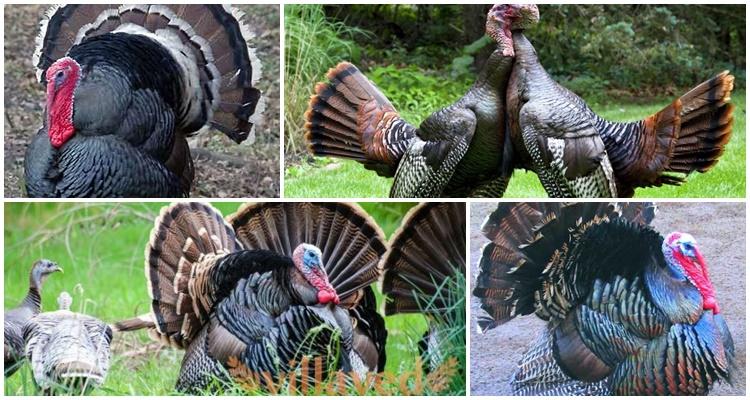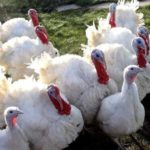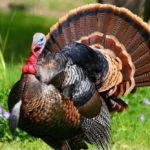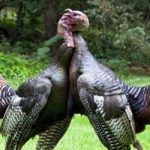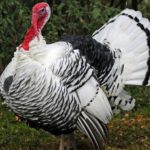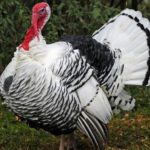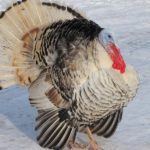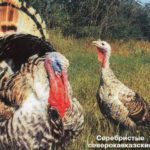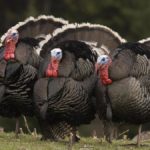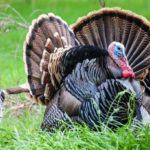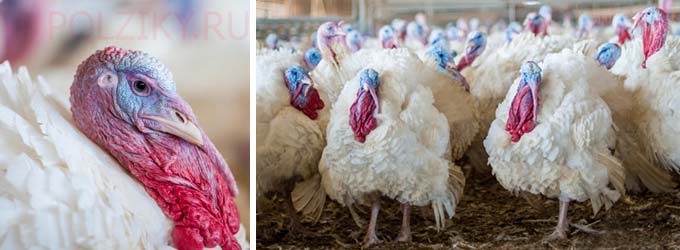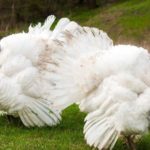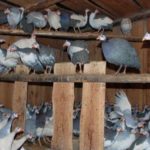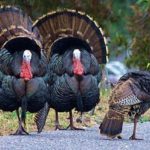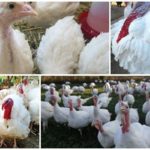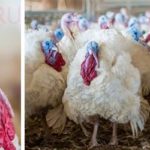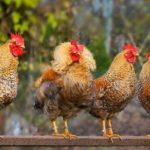Turkeys of the North Caucasian breed belong to the meat category and are one of the largest varieties of poultry. They are popular in private farms due to their early maturity and rapid weight gain. The resulting turkey meat is low in fat and is valued as a dietary product. The birds are adapted to grazing and indoor keeping and look spectacular due to their unusual color.
History of the breed
The North Caucasian turkey first appeared in 1946 in the Stavropol Territory.The broiler variety was obtained by crossing the American broad-breasted bronze breed and local turkeys. The new breed has adopted its meatiness from its foreign ancestors. The genes of domestic poultry have made broilers resistant to cold and unpretentious in care. Broad-breasted turkeys are only suitable for indoor housing, while Stavropol hybrids can be released onto pasture.
The breed was officially recognized in 1964, became popular in the North Caucasus, in the southern regions of Russia, and also attracted the interest of foreign breeders. Birds were purchased by farms in Bulgaria, Germany and Central Asia.
Characteristics and description of birds
External features of North Caucasian turkeys:
- large body, expanding towards the sternum;
- sculpted pectoral muscles;
- powerful wings that fit tightly to the body;
- strong long legs;
- a small head on a medium-length neck is covered with red coral growths.
Females differ from males in their smaller size and a small growth above the beak. The age of turkeys can be recognized by their paws - in older individuals they become lighter. Growths on the head serve as an indicator of mood. Restless birds' corals darken.
Productivity indicators:
- the weight of an adult turkey is 13-14 kilograms;
- turkey weight - 7 kilograms;
- the weight of a turkey chick at 4 months is 4 kilograms;
- egg production of one female per year is 75-80 eggs;
- Fertility rate - over 90 percent;
- chick survival rate is 80-90 percent.
Turkey poults are ready for slaughter at 5-6 months. Birds reach sexual maturity at 9 months.
Varieties
North Caucasian turkeys are distinguished by color: white, bronze and silver.
White
According to productivity, there are three subspecies:
- heavy - 35 kilograms;
- medium - 16 kilograms;
- light - 10 kilograms.
The breed is used in breeding work. When keeping snow-white turkeys, you need to be especially careful about the cleanliness of the poultry house.
Bronze
A distinctive feature of the breed is the golden hue of the feathers with a green tint. The dark plumage looks tough and from a distance resembles a shiny shell, decorated with a wide fan tail.
Bronze breed turkeys are distinguished by strong immunity and high survival rate of chicks. Adult birds gain 22 kilograms. The breed is often raised on private farms. To hatch chicks you will need an incubator.
Silver
The breed is distinguished by colored plumage and white down. The body constitution of birds is the same as that of other species: wide chest and back, heaviness, strong wings and legs.
The average weight of silver turkeys is 15 kilograms.
Pros and cons of North Caucasian turkeys
The fat content in turkey meat of the North Caucasian breed is 8 percent. After slaughter, 58 percent of the carcass weight is used for sale. The advantage of the breed is its calm nature.North Caucasian turkeys live in herds and tolerate being kept in a limited space well. Bronze turkeys appear black after plucking due to their dark plumage.
Rules of maintenance and care
A brick or wooden building is suitable for breeding North Caucasian turkeys. Optimal planting density per square meter:
- five-day-old chicks - 15;
- two-month-old turkey poults - 10;
- young birds from four months - 5.
One square meter is enough for two adult birds. But a smaller area will already lead to conflicts. North Caucasian turkeys are kept on pasture in the summer and indoors in the winter.
Requirements for arranging a poultry house:
- optimal temperature - +17 degrees;
- lighting - natural and artificial;
- humidity - 60 percent;
- ventilation - for ventilation in winter, install a hood, open a window in summer;
- litter - peat, sawdust, straw.
North Caucasian turkeys will survive temperatures below five degrees Celsius, but will stop gaining weight and laying eggs. The litter is changed at least once every ten days and loosened every day.
Poultry house equipment:
- feeders - round hanging ones, separate for different types of food;
- drinking bowls - cup or nipple systems are convenient for birds, water does not splash on the litter;
- perches with trays below for collecting droppings.
In the summer, a grass-filled walking area is fenced off next to the poultry house. Birds gain weight faster in the fresh air. The fence is made of metal mesh 2.5 meters high.
Diet planning
Feeding the hatched chicks begins with boiled finely chopped eggs. On the third day they are given cottage cheese and wheat porridge. From the fourth day, turkey poults can be fed with starter feed softened in meat or fish broth. Wet mash is also prepared with cottage cheese and soybean meal. In the second week of life, boiled potatoes, carrots, bone meal and chopped herbs are added to the mash.
Approximate diet of young animals:
| Component | Number in percentage by age | ||
| 1-2 months | 2-4 months | 5-6 months | |
| Corn | 37 | 40 | 33 |
| Wheat | – | 18 | 10 |
| Barley | – | – | 35 |
| Peas | 7 | – | – |
| Soybean meal | 9 | 9 | – |
| Feed yeast | 3,55 | 5 | 3,3 |
| Meat and bone meal | 8 | 5 | 1,4 |
| Skimmed milk powder or milk | 5 | – | – |
| Grass (alfalfa) meal | 3 | 5 | 7 |
| Loose chalk, crushed limestone or shell | 0,45 | 1,7 | 1,9 |
| Salt | – | – | 0,4 |
In the diet of adult turkeys, the proportion of barley is reduced to twenty percent and feed yeast is added. Laying hens are given dairy products, fish and meat and bone meal.
Reproduction methods
North Caucasian turkeys reproduce naturally. There is one male for every 10 females. The natural method of reproduction is traumatic for females. Males are twice as heavy and injure them with their claws. Therefore, farmers choose small turkeys for breeding and trim their claws. Artificial insemination is more often used in poultry farms. But both methods give equally high results.
Large eggs with smooth shells are selected for hatching. One hen hatches 15 eggs. The chicks begin to break through the shell on the 25th day.
Frequent illnesses
Common diseases of turkey poults:
- enteritis - accompanied by diarrhea, difficulty swallowing, lack of appetite and apathy;
- cannibalism - manifests itself in aggressive behavior, birds peck at weak relatives.
Sick turkey poults are isolated from the flock. Enteritis is treated with antibiotics and the freshness of feed is monitored.Aggressive individuals are given more bone meal and meat scraps mixed in broth.
Diseases dangerous for adult birds:
- histomoniasis - parasites in the intestines, internal organs, muscles;
- aspergillosis - fungal infection of the respiratory tract;
- coccidiosis - the spread of coccidia bacteria in the intestines and liver.
Unhealthy birds refuse food and become apathetic. When the fungus develops in the respiratory tract, turkeys stretch their necks and throw their heads back. With worms and bacterial damage to the intestines, birds lose weight and suffer from diarrhea with green or bloody impurities.
Infections are treated with antibiotics at the first sign of illness. But diseases in the acute phase often lead to the death of birds within a day or two. Therefore, it is important to carry out prevention - vaccinate the chicks, disinfect the poultry house and protect turkeys from contact with wild birds.

